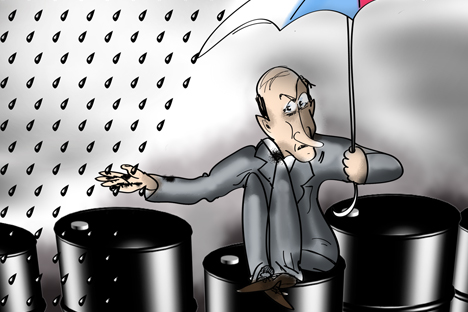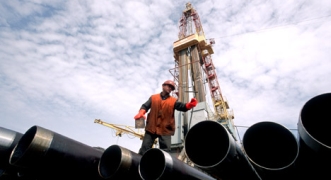Shale revolution hits Russian exporters

Click to enlarge the image. Drawing by Niyaz Karim
Recently, more and more analysts and experts have begun wondering how long Russia can remain one of the world’s leading global exporters of raw hydrocarbons. The latest trends in the development of the petrochemical sector indicate that competitors are emerging where they were least expected.
The biggest importers are declaring that they are prepared, at least in part, to refuse imports of oil and gas.
The so-called shale revolution could become a threat to the Russian market. The United States began to invest in developing shale oil and gas extraction technology around 15 years ago, and today they have partly succeeded in replacing imports and reducing the price on the internal market.
The reason behind the development of shale oil extraction was a decade of high oil prices, which began in 2004. America, as the largest consumer of hydrocarbons, was forced to look for alternative ways to be self-sufficient with its resources. However, with oil prices at $100 per barrel or higher, it became profitable to invest in “indigenous extraction,” despite the exceptionally high initial cost.
The initial cost of shale oil extraction is between $70 and $90 per barrel, which is significantly higher than that of traditional oil; yet it still makes sense, when oil prices on the global market are at $100 per barrel.
Russian companies did not see any sense in investing in these unprofitable projects, as there are a large number of untapped deposits with an initial extraction cost of only $20 per barrel. In the end, America, having invested in new technology, has achieved a breakthrough and is now on its way to being self-sufficient in energy.
Analysts at the Goldman Sachs bank are certain that, by 2017, the U.S. will become the world’s largest oil producing country. Production could rise from 8.3 million to 10.9 million barrels of oil a day and overtake production in Russia and Saudi Arabia.
What does this mean for Russia? Any increase in production means that the price will go down on the global energy market. For countries, this means a sharp reduction in budgetary income.
As far as the petrochemical sector is concerned, it cannot be competitive without modernization and the development of production and infrastructure. Competiveness has to be maintained, so as not to lose established markets.
Thus, Western Europe is Russia’s “favorite consumer.” It has infrastructure in place to transport oil, and tankers can be used to conveniently deliver oil products via the Black Sea. A great deal of production is concentrated in Germany, Italy and France, which ensures stable consumption. There is however one small problem: Ecological requirements are increasing all the time in Western Europe.
The introduction of the EURO 5 ecological standard intended to reduce harmful emissions into the atmosphere is forcing Russian companies to invest in modernizing production. It is possible, while oil prices are higher than $100 per barrel, to invest in modernizing technological processes and creating pipeline systems.
However, it is a completely different situation if global prices are to fall due to an increase in production.
Russian petroleum experts are proceeding on the basis that, if America is close to achieving self-sufficiency from foreign imports of oil, Western Europe will require supplies from Russia for a long time to come. Opportunities for shale extraction are limited in Western Europe by a lack of space and ecological risks.
For confirmation of the European orientation among Russian producers, one need only recall the construction of the Yug pipeline, which is a Rosneft project. It is aimed at creating a pipeline system to export Russian light petroleum products from the Black Sea coastal region.
According to data from Rosneft, the project proposes construction of an oil transportation pipeline on a route that runs through Syzran, Saratov, Volgograd and Novorossiysk. This pipeline will have a capacity of 8.7 million tons per year.
Eastern European countries also maintain their faith in Russian oil. Historically, it worked out that, in Eastern Europe, all delivery infrastructure for oil and oil products was orientated toward supplies from the former Soviet Union.
Now, in a time of crisis, there is no sense in making any cardinal changes. In terms of countries in the Far East — namely China and Japan — they are dynamically developing economies, which are in constant need of large quantities of energy resources. China, in particular, is the world’s second biggest consumer of raw hydrocarbons.
These countries are also trying to reduce their dependence on imported energy resources, including those from Russia. Only now are they starting pilot projects to develop shale deposits.
The Japan Petroleum Exportation Company (JAPEX) is planning to start exploratory shale extraction in northern Japan, close to the city of Oga in the Akita Prefecture, in 2014. China, which at present is in third place in terms of combustible shale deposits, is not lagging behind, either. All this, however, remains in the distant future.
Correspondingly, Russia has only 10 years to do everything possible to prevent departure from the market. Demand for oil supplies to China is bound to increase, as Beijing is only now beginning to develop shale oil extraction.
An agreement signed as part of the St. Petersburg Economic Forum between Rosneft and the China National Petroleum Corporation to supply oil to China for a period of 25 years is a significant step in this direction.
The Russian company will supply China with 300,000 barrels of oil a day, starting in 2015. The “black gold” will flow along a pipeline from Eastern Siberia to the Pacific Ocean. Incidentally, the China Development Bank has provided the finance for this pipeline.
Thus, the development of shale technology around the world does not hold any promises for Russia, since, in the long term, Russian exporters will be left with just the Western and Eastern European markets.
This, however, does not mean that they will lose all their income. Russian companies will continue to be profitable on account of a sufficiently high marginal sum from exporting hydrocarbons. Still, the era of high oil earnings will come to an end.
Natalia Lebedeva is a financial analyst and general director of the consulting company Miravil Group.
All rights reserved by Rossiyskaya Gazeta.
Subscribe
to our newsletter!
Get the week's best stories straight to your inbox



